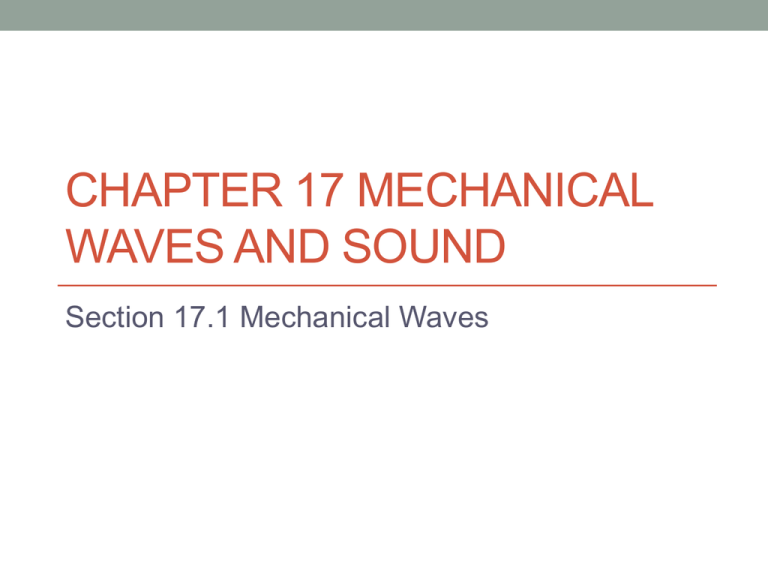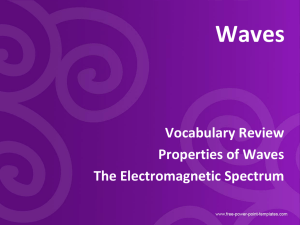Chapter 17 Mechanical Waves and Sound
advertisement

CHAPTER 17 MECHANICAL WAVES AND SOUND Section 17.1 Mechanical Waves 17.1 Mechanical Waves • Interest Grabber (journal entry) • Vibrations • A wave is a vibration that carries energy from one place to • • • • • another. But not all vibrations are waves. Hold a pen lightly between your thumb and index finger. Shake your hand back and forth to make the pen seem to bend like it’s made of rubber. Next, watch as the instructor holds a length of string and shakes the string back and forth. Observe the vibrations. Questions: 1. Describe the motion of the pen and the motion of the string. 2. In which case did the vibration move from one place to another? In which case did the vibration stay in one place? 17.1 Mechanical Waves • Review Energy- the ability to do work. • 1. Potential Energy- stored energy as a result of position or shape. • 2. Kinetic Energy- energy of motion • Mechanical Waves- A disturbance in matter that carries energy from one place to another. • Needs matter to travel through • The material through which the wave travels is called the medium. 17.1 Mechanical Waves • Medium- can be a solid, liquid or gas. • Ex: water- travel on surface, Rope- rope is the medium A mechanical wave is created when a source of energy causes a vibration to travel through a medium (a vibration is a repeating back and forth motion) Ex: Shaking a rope- energy added to one end, the wave that results is a vibration that carries energy along the rope. 17.1 Mechanical Waves • 3 Main Types of Mechanical Waves • 1. Transverse waves • 2. Longitudinal waves • 3. Surface waves 17.1 Mechanical Waves • 1. Transverse waves- a wave that causes the medium to vibrate at right angles to the direction in which the wave travels. • Crest- the highest point of the wave, above the rest position. • Trough- the lowest point below the rest position. 17.1 Mechanical Waves • Picture of Transverse Waves 17.1 Mechanical Waves • 2. Longitudinal waves- a wave in which the vibration of the medium is parallel to the direction the wave travels. • Ex: Coils of a spring • Compression- area where the particles in a medium are spaced close together. • Rarefaction- area where the particles in a medium are spread out. 17.1 Mechanical Waves 17.1 Mechanical Waves • Surface waves- a wave that travels along a surface separating two media. • Ex: An ocean wave is a surface wave between the water and the air. • Looking at a bobber in the water- at the crest the bobber moves up and at the trough the bobber moves down. 17.1 Mechanical Waves • Surface Wave 17.2 Properties of Mechanical Waves • Periodic motion- any motion that repeats at regular time intervals. • Ex: Surfers counting the time between 2 successive crests. • Properties used to describe waves • 1. Period 4. Speed • 2. Frequency 5. Amplitude • 3. Wavelength 17.2 Properties of Mechanical Waves • 1. Period- the time required for one cycle, a complete motion that returns to its starting point. • Ex: An ocean wave- time between 2 crests • 2. Frequency- the number of complete cycles in a given time. • Ex: For a wave- the number of wave cycles that pass a point in a given time. 17.2 Properties of Mechanical Waves • Measured in cycles per second or hertz • Look at Figures (A and B) P. 504 • A waves frequency equals the frequency of the vibrating source producing the wave. • 3. Wavelength- the distance between a point on one wave and the same point on the next cycle of the wave. • Transverse wave- the wavelength is measured between crests or troughs • Longitudinal wave- the distance between adjacent compressions and rarefactions. 17.2 Properties of Mechanical Waves • 4. Wave Speed- calculated by dividing its wavelength by its period or by multiplying wavelength by frequency. • Speed = distance • Time • Speed = Wavelength × Frequency • The speed of a wave can change if it enters a new medium or if pressure or temperature change. 17.2 Properties of Mechanical Waves For most waves the speed is constant for a range of different frequencies. If waves are traveling at a constant speed, then wavelength is inversely proportional to frequency. Ex: lower frequency- longer wavelength higher frequency- shorter wavelength 5. Amplitude- maximum displacement of the medium from its rest position. The more energy a wave has the greater the amplitude. 17.3 Behavior of Waves • Reflection- when a wave bounces off a surface that it cannot pass through. • Ex: Like a ball bouncing off a wall • Does not change the speed or frequency of a wave, but the wave can be flipped upside down. • Refraction- is the bending of a wave as it enters a new medium at an angle. 17.3 Behavior of Waves • Ex: Pushing a lawnmower- going from grass to gravel. Speed difference between the two wheels causes the lawnmower to change direction. • When a wave enters a medium at an angle, refraction occurs because one side of the wave moves more slowly than the other side. • Ex: ocean waves that enter shore on an angle refract, parallel to shore do not. 17.3 Behavior of Waves • Diffraction- the bending of a wave as it moves around an obstacle or passes through a narrow opening. • Ex: like the ripples made when a pebble is tossed into a pond. • A wave diffracts more if its wavelengths this large compared to the size of an opening or obstacle. 17.3 Behavior of Waves • Interference- occurs when 2 or more waves overlap and combine together. • There are 2 types of interference. • Constructive interference- this is when the amplitude is increased. Waves line up crest to crest. • Destructive interference- the amplitude decreases. The waves do not line up correctly. Crest of one wave hits the trough of another wave. 17.4 Sound and Hearing • Sound waves are longitudinal waves- compressions and rarefactions that travel through a medium. • Behaviors of sound can be explained using the following properties: speed, intensity, loudness, frequency, and pitch. • 1. Speed- the speed of sound varies in different media. 17.4 Sound and Hearing • Sound travels the fastest in solids and slowest in gases. • The reason why is that the particles are closer together in a solid than in liquids and gases. • Speed of sound depends on many factors such as the density of the medium and how elastic the medium is. 17.4 Sound and Hearing • Intensity and Loudness • 2. Intensity is the rate at which a waves energy flows through a given area. • Sound intensity depends on the waves amplitude and the distance from the sound source. • When someone whispers in your ear can have greater sound intensity than someone shouting across a field. • Measured in decibels (dB) 17.4 Sound and Hearing • 3. Loudness- is more subjective than intensity because it is how somebody physically responds to the intensity of sound. • As intensity increases so does loudness. • However, the health of your ears and how your brain interprets the information can determine loudness too. 17.4 Sound and Hearing • Frequency and Pitch • 3. Frequency of a sound wave depends on how fast the source of sound is vibrating. • The faster the vibration the higher the frequency. • Ex: instruments- A trumpet produces higher frequency than a french horn. 17.4 Sound and Hearing • 5. Pitch is how you perceive the frequency of sound. • High frequency sounds have a high pitch. • Low frequency sounds have a low pitch. • Depends on age and health of ear. Older people have a harder time hearing a high pitch. • Most people hear between 20 Hz and 20,000 Hz. 17.4 Sound and Hearing • Ultrasound- is sound at frequencies higher than most people hear. • Used in sonar and ultrasound imaging. • Sonar stands for sound navigation and ranging. • Used to determine the distance to an object under water. • Ultrasound shows images by sending ultrasound pulses into a patient. 17.4 Sound and Hearing • Doppler Effect- a change in sound frequency caused by motion of the sound source, motion of the listener, or both. • Discovered by Christian Doppler an Austrian scientist. • As a source of sound approaches, an observer hears a higher frequency. When the sound source moves away, the observer hears a lower frequency.





